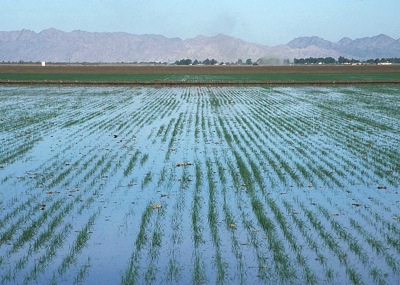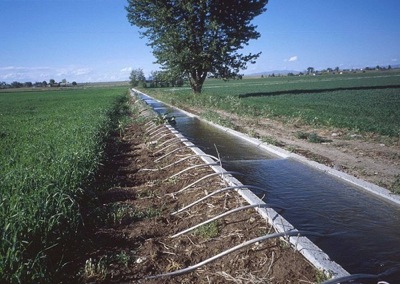Ken Cassman at University of Nebraska spoke with EarthSky on the subject of water for food. Cassman is a professor of agronomy – the science of soil management and crop production. He said that more than two-thirds of the water humans use is to produce food. He asked: How can we grow more food for the greater numbers of people expected on Earth in this century – using the same or less water than we’re using today? Dr. Cassman said irrigation will be a big part of the answer.
The big picture is that the importance of irrigated agriculture is only going to increase because we only have so much good, arable land with suitable soil, and because we don’t want to expand agriculture into the last remaining rainforests and wetlands.

He said he expects irrigation practices to change dramatically.
At a large scale, we can think of systems that are completely integrated with real-time satellite image data, real-time soil-sensing across a large field, and when it needs water most and when it can be withheld without a large decrease in yield, and all of this in real time, so we’re matching precisely the supply of water with the need of every plant on that field.
But, he said, irrigated agriculture has to be sustainable. Cassman said:
In fact we have to ask more of it. And we have to add the proviso that we have to do it in a way that protects water resources and quality at the same time. And if you put that challenge before talented young scientists, young men and women, and ask them to solve that explicit problem for us, I guarantee you: it can be done.

Cassman said large-scale agricultural changes are going to have to be made – for example, many farms now fed by rain will have to move over to irrigation-fed. And many farms already fed by irrigation will have to improve the technology they’ve got
He also talked more about the specifics of irrigation. He said that how widespread the best irrigation technologies wind up might depend on the future price of food:
There are ways with irrigation to achieve substantial improvement in water productivity. But, a lot of this will depend on the future price of food. Right now there are technologies that are incredibly water-efficient. For example, irrigated agriculture is often seen as a floodgate and water pours onto a field until it’s saturated. Of course, you can invest in a pivot system, a system that delivers water not through a sprinkler, because that shoots it into the atmosphere and it evaporates. But we have now a low-pressure pivot system that dribbles water onto the soil, and 90-95% of that is used by the plant. But of course that’s a large capital investment.
But you can go beyond that. Crops in California that are of extremely high value – lettuce, almonds, cotton – they’re grown with drip irrigation. The tubing is below the surface, a foot and a half deep, so the water never has to sit on the surface where it can evaporate. The water is directly delivered to the root zone.
He says that irrigation is scale neutral – this is, you can design as good a system for a small farmer in Africa as for an industrial farmer in the U.S. He gave an example of a large system, and then a small.
There’s a small drip system that can be used by a farmer with say a small patch of land the size of a bedroom where a farm family can produce high value crops to supplement income and supplement diets. And at a large scale, we can think of systems that are completely integrated with real-time satellite image data, real-time soil-sensing across a large field, and when it needs water most and when it can be withheld without a large decrease in yield, and all of this in real time, so we’re matching precisely the supply of water with the need of every plant on that field.
In the future, Cassman believes, food will be more valuable, and that small farmers will be able to afford some of the irrigation technologies they may not be able to afford today. He told EarthSky:
I think the larger question is not the technologies and the science but how we get the educational support and the infrastructure. Because when you’re talking about these developing countries, small farmers, you’re dealing with millions of them. And so the infrastructure needed to reach on those people is a challenge. But I think the key here is that farming needs to be more profitable.
Agriculture needs to be profitable, and irrigation needs to be sustainable, he said.
In fact we have to ask more of it. And we have to add the proviso that we have to do it in a way that protects water resources and quality at the same time. And if you put that challenge before talented young scientists, young men and women that can solve that explicit problem for us, I guarantee you: it can be done.
Listen to the 90-second EarthSky interview with Ken Cassman on water for food (at top of page.)Submit your own Earth or night sky photos at EarthSky Community Photos.











